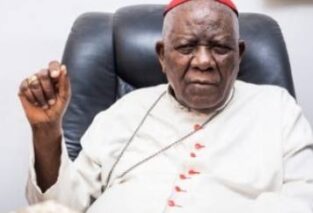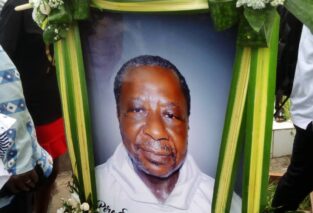Many a Catholic Community in Cameroon has adopted what is generally referred to as the “Lectionary Procession”. As an introduction to the Liturgy of the Word, Lectionary is brought to the President of the Liturgical Assembly in a colourful procession, very often marked by song and dance. While the general populace delights in the singing and dancing that accompany this procession, some Christians find it too time-consuming and loudly call for such processions to be either tightly controlled or banned altogether. To know more, we asked Reverend Father Zephyrinus Mbuh, SD, a liturgical expert (liturgist) of the Diocese of Kumbo in the Bamenda Ecclesiastical Province of Cameroon (picture below), to throw more light on this issue.
Father, what is a Lectionary Procession?
The Roman Catholic Liturgy actually prescribes a procession with the Book of the Gospels, which takes place just before the proclamation of the Gospel. The term ‘Lectionary Procession’ was coined at the initiative of the Bamenda Ecclesiastical Province, which initiative came up in preparation for the visit of the Holy Father Pope John Paul II in 1985. The argument in support of a ‘Lectionary Procession’ is that the Word of God is One – there is no separation between the First and/or Second Reading and the Gospel. This is definitely an initiative that has received Roman approval, even if practised for the most part on Cameroonian soil or by Cameroonians elsewhere around the world.
Some people find such processions rather long. Can’t they be done much faster?
The question of precision and brevity in the Liturgy is something whose importance we cannot over emphasise. People do not come to church because they have nothing else to do! Coming to church is only one of the items on their agenda, even if for many it is the most important item. The Priest and any other person who has a role to play in the Liturgy must bear in mind the fact that people come to church to spend quality time with God and with their brothers and sisters in worship. The church is not a cinema hall, neither is it a funeral home! We need to animate the Liturgy in such a way that it is done with precision, reverence, respect for the sacredness of the church and its occupants.
The precise mark of respect given to the Word of God is not in the carrying of the Lectionary or the Book of the Gospels around, but in reading it and listening to it such that it produces its desired effects in its readers and hearers. Spending so much time in bringing the Word of God in procession is definitely missing the mark! A Lectionary Procession that goes beyond 3 to 5 minutes becomes a distraction, no matter the occasion!
It sometimes takes quite a while for the Lectionary Procession to even start. What do you see as a solution to this problem?
The Lectionary Procession does not need to start from the back of the church. It should take place from as near the sanctuary as possible. Those taking part in the Lectionary Procession dress for Mass and not for the Lectionary Procession. In other words, they do not vest and unvest at the back of the church while Mass is going on! They need to make sure that the attire they use for the Lectionary Procession is such that they can and will effectively use for the whole duration of the Mass. Whatever they carry in procession as symbols that give meaning to the procession and respect to the Word of God must be such that they can either keep them near the Lectern or carry them with them where they are sitting in church. It is not apt for people to stand around the Lectern with peace plants or any objects (themselves included) that block communication between the one proclaiming the Word of God and the Assembly. The proclamation of the Word of God should be done in a language that the people understand. In case of a mixed congregation, it might be useful to proclaim each reading in one and only one of the languages of the congregation.
Would you say that the Lectionary Procession is the sole culprit in the crime of time robbery in the Liturgy?
Not at all! The Entrance Procession, the Lectionary Procession, the Proclamation of the Readings, the Homily, the Prayer of the Faithful, the Offertory Procession and the Notices constitute a whole collection of collaborative time killers. The Entrance Procession should be executed in such a way that the Sign of the Cross is taken when Mass is programmed to begin. If Mass is to begin at 9.00 a.m., for instance, the Entrance Procession does not begin at 9.00 a.m. This depends to a very great extent on the Master of Ceremonies, who should have a very clear idea of how long the Mass is intended to last and should make sure that each person who has a role to play fulfils his/her role within schedule.
Sometimes one has a feeling that such processions are not always well prepared given the confusion that always seems to reign among the procession participants themselves prior to, or during the procession.
You’re right. The Liturgy, well prepared and executed, is in itself catechesis. It is definitely necessary for all who have a part to play in any Liturgical Assembly to come together and prepare well for the celebration. That is why it is always necessary to take time and rehearse our roles, even when we know them by heart. Imagine a non-Catholic who comes to theCatholic church for the first time, and many do, and witnesses a Liturgical Celebration characterised by wrong emphases! What would such a person go home with? If they came and witnessed a well prepared and celebrated Liturgy, they would go home edified to have witnessed the way Catholics celebrate.
Lengthy homilies pose quite a problem to many people too. What would you say is the “ideal” length of a homily?
A homily of 5 to 10 minutes is great. If it must be longer, it should be limited to 15 minutes; otherwise the preacher runs the risk of preaching for the archives. Not many speakers are capable of sustaining their audience’s attention beyond 15 minutes.
I’ve been in a church where up to seven people read the Prayer of the Faithful. Is that number of readers needed to bring the intentions of the faithful to the Father?
No, I don’t think so. God hears the prayers of his sons and daughters when they pray in community and when they pray as individuals. As far as the Prayer of the Faithful is concerned, even if there are as many as 5 to 7 intentions, they can all be announced by one or two persons. A group of 5 to 7 persons is not necessary! It’s too much of a crowd around the Lectern.
What should be the content of the Prayer of the Faithful?
It should include an intention for the Church and her Ministers, an intention for civil and traditional authorities, a few intentions for the needs of the worshipping community and its members. It is praiseworthy to give room for members of the Assembly to pray in silence for their other intentions which have not yet been mentioned and then to seek the intercession of the Blessed Virgin Mary. The response to the intentions must be clear, precise and easy to memorise, whether it is recited or sung. Long and windy responses must be avoided to save time and also not to raise any doubts in the minds of the gathered faithful.
Tell us about the Offertory Procession. Is it necessary?
Wow! I can visualise Parish Priests ready to take up arms against you for a question like this! The Offertory Procession is not optional in any Mass. The Mass is a Sacrifice and the bread and wine to be used for the Sacrifice need to be presented by the people. This is the essence of the Offertory Procession. If there are monetary gifts and other gifts in kind to be offered along with the bread and wine, these derive their meaning and place from the offering of bread and wine and they should be offered with the same spirit – in generosity, reverence and respect. It is important for our people to realise that what matters is not how many times one approaches the alms basket in the same Mass, but how much one puts in it with love that springs from the very depth of one’s being. With this understanding we do not need to go to one particular alms basket/box but to the alms basket/box nearest to us as long as it serves the purpose of the collection. It is important to get sufficient alms baskets/boxes that meet the size of the congregation and to place them in strategic positions so that people do not need to travel long distances to offer their gifts. Even for the biggest of Masses the offertory procession should not take more than 20 to 30 minutes.
What we are basically saying here, Father, is that the Mass can be kept short without losing its solemnity. Am I right?
Solemnity comes from the respect and reverence that accompany diction and gestures in the Liturgy. The articulation of words in a natural way and the clarity of the sound system have a lot to contribute to solemnity and the attention of the worshipping community. Without losing sight of solemnity, we can conveniently limit weekday Masses to a maximum of 35 minutes; Sunday Masses to a maximum of 90 minutes, and the big occasional Masses to a maximum of 180 minutes.
What I have said here is not the Gospel of the Lord, but rather a collection of random and useful ideas that will go a long way to help us in our Liturgical Planning and Execution. We should, of course, not forget to mention the notices/announcements, which as a matter of principle, are given after the post-Communion Prayer. They should contain only a few points that are not in the Sunday Newsletter or that need special emphasis. Notices that go beyond 5 minutes unnecessarily prolong the Liturgy. Thank you.


